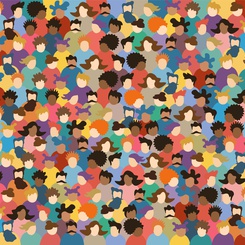With ESSEC Knowledge Editor-in-chief
How can we understand the American election?
Using over 200 million social media posts, media hits, advertising information, and poll results, Raoul Kübler (ESSEC Business School) alongside Kai Manke (University of Münster) and Koen Pauwels (Northeastern University), mapped a framework, published in the Journal of Business Research, for understanding political marketing - and understanding the role of disinformation and media. Looking at the 2016 and 2020 American presidential elections, they provide advice for campaign managers, policymakers and media professionals - and shed insight into understanding what will happen this time around.
It’s not enough to have good policies and political experience, as Hillary Clinton learned to her detriment in 2016: knowing how to market yourself is key for convincing the masses to cast a ballot. It’s now a billion-dollar enterprise, with candidates expected to spend a whopping 12 billion US dollars in marketing for the 2024 election. From this budget, more than 650 million US dollars will go to social media spending.
Social media: friend or foe?
Social media has changed the game in politics and traditional media. Candidates need a social media presence - and traditional media outlets must compete with social media for readers and advertising money. As a result, traditional media has adapted their strategy - and been accused of letting their standards slide to remain relevant. In a similar vein, social media (in particular Elon Musk’s X) has come under fire for the wildfire spread of disinformation, seen as a threat to democracy. While we know that this disinformation has an impact on candidate support (e.g. 1, 2, 3), it’s less clear how it impacts - and is impacted - by other players in political marketing, like campaigns, media, and offline word-of-mouth. The researchers put together a framework to better understand the political marketing landscape.
A framework for understanding political marketing
Why is this new framework necessary? The contemporary marketing scene includes both digital and traditional media, and can be seen as an “echoverse”, with dynamic interactions between stakeholders. This means the relationships are feedback loops - with parties influencing each other. The researchers mapped out the relationships between these stakeholders to better understand how the political echoverse works - and how stakeholders can better understand their role.
The framework includes campaign spending, media coverage, disinformation, social media, and offline-word-of-mouth. Using text mining tools, the researchers gathered a rich dataset with over 200 million data points on social media communication (Twitter, Instagram, Facebook), online chatter, offline word-of-mouth, disinformation-sharing behavior, media coverage, election polls, and donations.
Looking at support, the researchers found that support, in the form of poll gaps, is hugely driven by word-of-mouth and media coverage, with disinformation coming in third. Word-of-mouth itself is influenced by both disinformation and polls - showing the nature of the feedback loops.
Disinformation nation
Disinformation, characterized as sharing links to known disinformation websites, is influenced by public opinion: namely polls (75%) and word-of-mouth (75%). They also found that disinformation drives media coverage, but media coverage does not drive disinformation: making this the only unidirectional relationship in the framework.
In the 2016 election, this led to a spiral effect for both Hillary Clinton and Donald Trump. An increase in support in the polls for Clinton led to a rise in disinformation targeting her on social media, which then led to a decrease in positive word-of-mouth, resulting in less media coverage. The Clinton campaign adapted to this by emulating Trump’s communication style on social media, emphasizing conservative values and focusing less on women’s rights, one of her key topics. In another example, when Trump’s sex scandals received air time, Clinton spent more on TV ad spots that talked about her economic prowess, leading to a boost in her poll numbers.
The Trump campaign responded to increased support for Clinton with social media posting, especially on Russia. His social media activity boosted the spread of disinformation targeting Clinton, leading to media coverage that attempted to address this disinformation. However, even this negative coverage didn’t dampen the enthusiasm of his supporters, instead leading to positive support. In other words, he managed to turn a gap in the polls to support, especially by leveraging disinformation.
They find that traditional media amplifies this disinformation, contributing to a polarized public debate. Disinformation doesn’t go away quietly, either: it has a pervasive, lasting impact on voter support.
The role of the element of surprise
The research team also looked at external events, such as Wikileaks, a New York Times article on the FBI finding no proof of Russian interference, and the Comey letter on Hillary Clinton’s emails. These also played their part in the network, by influencing voter support, disinformation, media coverage, and candidate behavior. However, candidates must not let these events distract them and must stay focused on their core strategy.
From 2016 to 2020
The researchers also looked at the case of the 2020 American election, looking at 132.6 million tweets between August 17th, 2020 and November 2nd, 2020. The topics may have differed, but the interactions remained the same. Disinformation remained a major player that even grew by factor four. This trend keeps going as we can see, as we witness a further increase in the 2024 presidential election. Media outlets report on social media stories, and campaign managers adapt their advertising and social media strategy accordingly. In this case, however, they found unidirectional links between disinformation and social media and word-of-mouth and social media. With similar patterns in both 2016 and 2020, we can expect the framework to prove useful for 2024 and future elections.
Understanding political marketing
How can we use this to understand the political marketing landscape? They find that advertising in offline media outlets (such as TV) remains important for driving support. Campaign managers also direct their funds to digital advertising, with 30% of ad budgets predicted to be into digital channels this cycle (4). This, too, is a worthwhile investment, despite a lesser direct impact on support compared to traditional media. Social media however is the key tool to foster and steer the public debate. We find that social media feeds traditional media (newspapers and TV). As journalists monitor the public debate on social media and use word-of-mouth to decide on which topics to cover, social media has become a key tool for agenda setting. This also leads to an amplification of the online debate and disinformation. Candidates are now aware how to use social media to drive online debates, which result in more media attention and ultimately in more public support. Donald Trump especially understood this dynamic relation and ultimately benefited in 2016, 2020, and now in 2024 from higher social media engagement and significantly higher media coverage.
The researchers are the first to show the extent to which disinformation influences the political system, as they find that it has an immediate and lingering effect on word-of-mouth - which in turn sways political support. It will come as no surprise to anyone familiar with the American elections that polarization drives online activity, with supporters reacting to poll gains by sharing disinformation. This disinformation is particularly effective when there is a grain of truth, like Hillary Clinton mishandling emails, as opposed to obviously fake, like the Pizzagate conspiracy theory. It also remains complicated to measure political support - and if campaigns are too reliant on one measure, it could lead to poor decisions (5).
So what are stakeholders to do, faced with these feedback loops?
Takeaways
-
For campaign managers:
-
Avoid an overreliance on poll numbers, and look at other types of support, like social media activity
-
Do not get sidetracked by external events: stay focused on your core strategy
-
-
For media professionals:
-
Develop a strategy for dealing with disinformation. Avoid clickbait coverage: but cover disinformation without making it seem legitimate.
-
-
For social media professionals:
-
Increase transparency about your platform’s activities. Most social media platforms (except TikTok and Youtube) no longer provide academic access like we had in the past, making their activity opaque.
-
-
For policymakers:
-
Consider investing in strategies to counter disinformation, such as new legislation to enforce consequences.
-
The results highlight the critical role of social media in political marketing, showing that it impacts candidate behavior, media coverage, and voter actions. Disinformation also emerges as a major player, driving political support and impacting the behavior of candidates and media via offline chatter. With disinformation unlikely to go away soon, and the Republican candidate wielding disinformation as a weapon, stakeholders like candidates and media professionals need to develop a strategy for countering this activity to maintain American democracy.
References
-
Allcott, H., & Gentzkow, M. (2017). Social media and fake news in the 2016 election. Journal of Economic Perspectives, 31(2), 211-236.
-
Guess, A. M., Nyhan, B., & Reifler, J. (2020). Exposure to untrustworthy websites in the 2016 US election. Nature Human Behaviour, 4, 472–480. https://doi.org/10.1038/ s41562-020-0833-x
-
Gunther, R., Beck, P. A., & Nisbet, E. C. (2019). “Fake News” and the defection of 2012 Obama voters in the 2016 presidential election. Electoral Studies, 61, 1–8. https:// doi.org/10.1016/j.electstud.2019.03.006
-
Clark, D. (2024). 2024 Political Ad Spending Will Jump Nearly 30% vs. 2020. Retrieved from https://www.emarketer.com/press-releases/2024-political-ad-spending-willjump-nearly-30-vs-2020. Accessed September 10, 2024.
-
Kübler, R., & Pauwels, K. (2021). Metrics gone wrong: What managers can learn from the 2016 US presidential election. NIM Marketing Intelligence Review, 13, 30–35.









